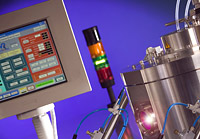Researchers at the University of Surrey have discovered a way to grow high-quality carbon nanotubes over large areas at substrate temperatures below 350ºC, according to findings published this month in Carbon journal.
This breakthrough by experts in the University’s Advanced Technology Institute means that lowering the substrate temperature below 400ºC would make this technology compatible with CMOS (a technology for constructing integrated circuits) and suitable for large area substrates.
As a result potential applications of carbon nanotubes – ranging from interconnectors for integrated circuits, solar cell electrodes, supercapacitors, electrodes for batteries and fuel cells to nano-composite materials for high strength materials in body armour, aircraft wings, vehicle chassis and stealth materials – would become feasible and affordable if the growth temperature of the substrates were to be reduced from its current 700ºC, the University of Surrey researchers said.
Carbon nanotubes are rolled up sheets of honeycomb-structured carbon atoms that are typically ten thousandth the width of a human hair or hundred thousandth of a millimetre in diameter. The single or multi-walled carbon nanotube structures have amazing electronic properties with conductivity better than any other known single element material including copper, thermal conductivity better than diamond, and extraordinary mechanical strength surpassing that of high tensile steel.
The breakthrough reported by Professor Ravi Silva’s group at the University of Surrey allows researchers to couple plasma energy more efficiently to the catalyst particles used to grow carbon nanotubes. The researchers have demonstrated that high-quality carbon nanotubes can be grown controllably, reliably and over large areas while maintaining the device substrates at low temperatures.
Dr Vlad Stolojan, a key researcher and author of the work published in Carbon, explained the technology used. “Currently the metallic interconnects based on the metal copper used in integrated circuits suffer from poor electrical conduction and, the smaller they get in diameter, the more resistive they become. In addition to the electromigration issues, they dissipate so much heat energy that they can damage the surrounding devices. With our innovative technology, using a top-down heating methodology, we can precisely grow carbon nanotubes within interconnect vias at CMOS compatible temperatures.”
The revolutionary technology developed with colleagues from the Advanced Technology Institute spin-out company, Surrey NanoSystems, has demonstrated growth of carbon nanotubes which have similar properties to those obtained at temperatures of 700ºC, over 4” wafers, while maintaining the substrate below 350ºC. “The system we have designed provides energy from the top via an infrared lamp array, whilst having several functional layers with carefully designed thicknesses which reflect this heat and/or act as thermal barriers for the substrate. The substrate itself sits on a water-cooled holder, to further protect it from harmful heating,” Dr Stolojan added.
Speaking about the discovery, Professor Silva said: “This radical and novel approach to carbon nanotube growth combines a decade of top-flight research at the University’s Advanced Technology Institute and delivers the type of innovation that UK industry can be proud of. This is an example of how private-public partnership can deliver real-world solutions to roadblocks in cutting-edge technologies. We are currently in talks with major semiconductor manufacturers to transfer this technology to the wider market and are continuing our internationally-leading research into novel contacting technologies.”
Prior Research
Nanotechnology journal – High-rate low-temperature growth of vertically aligned carbon nanotubes
We report the low-temperature growth of vertically aligned carbon nanotubes (CNTs) at high growth rates by a photo-thermal chemical vapour deposition (PTCVD) technique using a Ti/Fe bilayer film as the catalyst. The bulk growth temperature of the substrate is as low as 370 °C and the growth rate is up to 1.3 µm min − 1, at least eight times faster than the values reported by traditional thermal CVD methods. Transmission electron microscopy observations reveal that as-grown CNTs are uniformly made of highly crystalline 5–6 graphene shells with an approximately 10 nm outer diameter and a 5–6 nm inner diameter. The low-temperature rapid growth of CNTs is strongly related to the unique top-down heating mode of PTCVD and the use of a Ti/Fe bimetallic solid solution catalyst. The present study will advance the development of CNTs as interconnects in nanoelectronics, through a CMOS-compatible low-temperature deposition method suitable for back-end-of-line processes.
Link to surrey nanosystems papers from 1998-2006 for CMOS compatible growth of carbon nanotubes.
Developed expressly for Carbon Nanotube applications, with ground-breaking research by the Advanced Technology Institute (ATI), and leading-edge plasma processing know-how from Surrey NanoSystems, the tool provides the research and development community with a highly practical Carbon Nanotube growth system, and comes with tested process recipes.
As standard, the NanoGrowth 1000n comes with both CVD (chemical vapour deposition) and PECVD (plasma-enhanced CVD) processing capability. These two techniques provide great versatility for users, allowing material growth at ‘standard’ temperatures in and around the 500-1000 degrees C range, as well as growth at lower temperatures.
Surrey NanoSystems produces highly advanced systems for Carbon Nanotube growth at High and Low (350 deg C and below!) temperatures – Our highly modular, systems expand the uses of CNTs making their integration possible for the next generation of silicon chips, removing roadblocks to their continuing development.
If you liked this article, please give it a quick review on ycombinator or StumbleUpon. Thanks

Brian Wang is a Futurist Thought Leader and a popular Science blogger with 1 million readers per month. His blog Nextbigfuture.com is ranked #1 Science News Blog. It covers many disruptive technology and trends including Space, Robotics, Artificial Intelligence, Medicine, Anti-aging Biotechnology, and Nanotechnology.
Known for identifying cutting edge technologies, he is currently a Co-Founder of a startup and fundraiser for high potential early-stage companies. He is the Head of Research for Allocations for deep technology investments and an Angel Investor at Space Angels.
A frequent speaker at corporations, he has been a TEDx speaker, a Singularity University speaker and guest at numerous interviews for radio and podcasts. He is open to public speaking and advising engagements.


